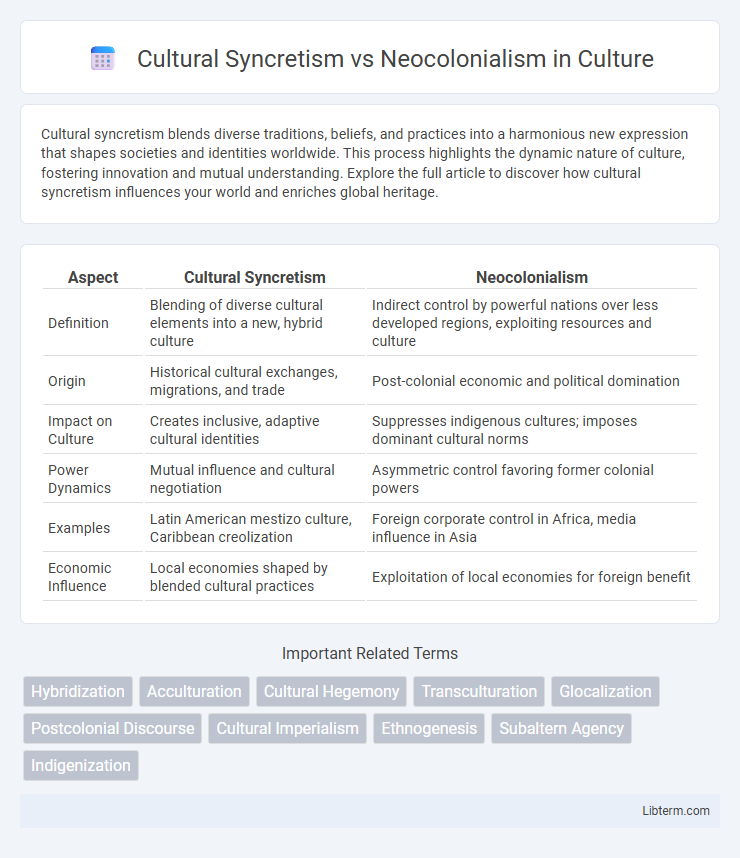Cultural syncretism blends diverse traditions, beliefs, and practices into a harmonious new expression that shapes societies and identities worldwide. This process highlights the dynamic nature of culture, fostering innovation and mutual understanding. Explore the full article to discover how cultural syncretism influences your world and enriches global heritage.
Table of Comparison
| Aspect | Cultural Syncretism | Neocolonialism |
|---|---|---|
| Definition | Blending of diverse cultural elements into a new, hybrid culture | Indirect control by powerful nations over less developed regions, exploiting resources and culture |
| Origin | Historical cultural exchanges, migrations, and trade | Post-colonial economic and political domination |
| Impact on Culture | Creates inclusive, adaptive cultural identities | Suppresses indigenous cultures; imposes dominant cultural norms |
| Power Dynamics | Mutual influence and cultural negotiation | Asymmetric control favoring former colonial powers |
| Examples | Latin American mestizo culture, Caribbean creolization | Foreign corporate control in Africa, media influence in Asia |
| Economic Influence | Local economies shaped by blended cultural practices | Exploitation of local economies for foreign benefit |
Defining Cultural Syncretism and Neocolonialism
Cultural syncretism refers to the blending of elements from different cultures, creating new, hybrid cultural practices, beliefs, and identities that emerge through interaction and exchange. Neocolonialism is the practice where powerful nations indirectly control or influence less developed countries through economic, political, or cultural pressures, maintaining the dominance established during colonial times. While cultural syncretism highlights mutual adaptation and fusion, neocolonialism emphasizes unequal power dynamics and the persistence of colonial exploitation under new forms.
Historical Roots: Syncretism Across Civilizations
Cultural syncretism has deep historical roots, evident in ancient civilizations such as the Roman Empire, where diverse religious practices blended to form new belief systems, and in the Americas, where indigenous traditions merged with European influences during colonial encounters. This process contrasts with neocolonialism, which often enforces cultural dominance and economic control rather than fostering genuine cultural exchange or mutual transformation. Understanding these historical syncretic phenomena highlights the difference between organic cultural integration and imposed hegemonic structures characteristic of neocolonialism.
Tracing Neocolonial Influences in the Modern Era
The modern era reveals neocolonial influences through economic dependencies, cultural homogenization, and political manipulation imposed by dominant nations on developing countries. Cultural syncretism emerges as a complex response, blending indigenous traditions with foreign elements while resisting overt neocolonial control. Analyzing trade practices, media representation, and educational curricula helps trace subtle mechanisms sustaining neocolonial power structures in contemporary global relations.
Key Differences Between Syncretism and Neocolonialism
Cultural syncretism involves the blending of different cultural elements to create new, hybrid identities, emphasizing mutual influence and adaptation among societies. Neocolonialism, in contrast, refers to the continued economic and political control exerted by powerful countries over less developed nations, often undermining local sovereignty and perpetuating dependency. While syncretism fosters cultural exchange and integration, neocolonialism maintains hierarchical dominance and exploitation.
Cultural Hybridity: Empowerment or Erasure?
Cultural hybridity emerges as a complex phenomenon where syncretism fosters creative empowerment by blending diverse traditions to produce new identities, while neocolonialism risks erasure through enforced dominance of hegemonic cultures. The negotiation of hybrid identities challenges static notions of culture, enabling marginalized groups to assert agency and resist colonial legacies. However, when power imbalances skew cultural exchanges, hybridity can become a tool for cultural homogenization rather than authentic coexistence.
The Role of Power Dynamics in Cultural Exchange
Power dynamics play a crucial role in shaping cultural syncretism and neocolonialism, often determining whether cultural exchange is reciprocal or exploitative. In cultural syncretism, power imbalances can lead to the dominant culture influencing or assimilating minority cultures, blending traditions while sometimes erasing original meanings. Neocolonialism intensifies this effect by using economic, political, or social control to impose cultural narratives that reinforce existing hierarchies and suppress indigenous cultural expressions.
Case Studies: Syncretism in Religion and Art
Cultural syncretism in religion and art manifests through the blending of indigenous African spiritual practices with European Christianity during the colonial era, producing unique forms such as Vodou in Haiti and Candomble in Brazil. Neocolonialism, however, often commodifies these syncretic traditions, exploiting them within global markets while perpetuating power imbalances and cultural appropriation. These case studies reveal how syncretism simultaneously serves as resistance to cultural domination and a site of ongoing negotiation amid modern economic and political pressures.
Globalization’s Impact: Blurring the Boundaries
Globalization accelerates cultural syncretism by blending diverse traditions, languages, and practices, creating hybrid identities that transcend national borders. Neocolonialism exploits these interconnectedness patterns by imposing dominant economic and cultural norms, often undermining local autonomy and cultural distinctiveness. The blurring of boundaries challenges traditional power structures, highlighting tensions between cultural integration and the preservation of indigenous values.
Resistance and Adaptation: Local Responses
Cultural syncretism fosters hybrid identities through the blending of indigenous and external influences, enabling communities to subtly resist neocolonial control by preserving core traditions while adapting new elements. Local responses often manifest in the reappropriation of colonial symbols and practices, transforming them into tools of empowerment and cultural affirmation. This dynamic interplay highlights resistance as a negotiation process where adaptation becomes a form of survival against neocolonial economic and ideological domination.
The Future of Cultural Identity in a Neocolonial Age
Cultural syncretism fosters the blending of diverse traditions to create new, hybrid identities that resist cultural homogenization under neocolonial pressures. In a neocolonial age, the future of cultural identity hinges on the ability of marginalized communities to reclaim and reinterpret their heritage while navigating global power dynamics. This ongoing interplay challenges the dominance of Western cultural paradigms and promotes resilience through localized creativity and expression.
Cultural Syncretism Infographic

 libterm.com
libterm.com